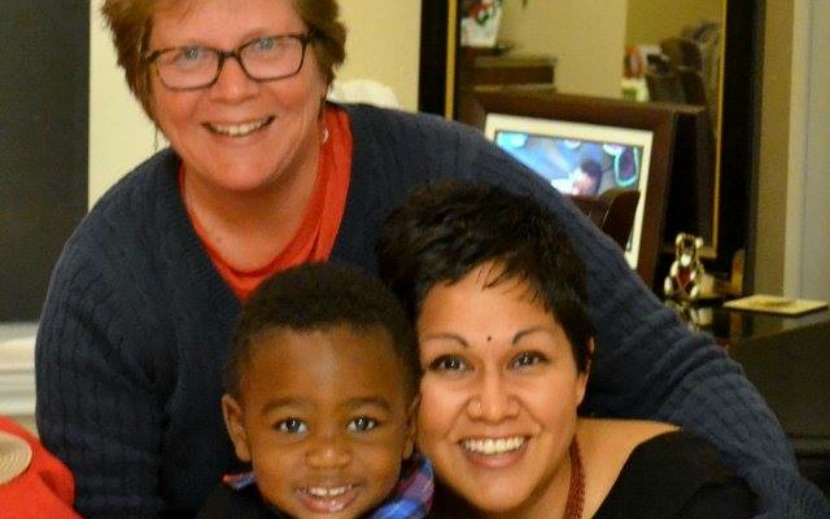10 Tips for a Successful Transracial Adoption

Yes, transracial is a thing. And it has nothing to do with white women who decide that they are Black.
Transracial refers to adoptive families of children with different cultures and races. Mash-Up families are complex. Adoptive ones especially so. In this, the third and final installment of a three-part series, our Indian-American Nishta Mehra provides concrete, specific tips on building and sustaining her transracial adoptive family, which is white, Black, Indian, gay, multiracial and full of love. Because sometimes we choose our families, and sometimes they choose us.
Make sure to read her searingly honest essays about her adoptive family, and how she built a village around it.
Mash-Up adoptive families face challenges that others don’t. Neither my white partner, Jill, nor I, look like our Black son, Shiv, or like each other. And this affects our family on a daily basis — at the grocery store, at Target, on a plane. If you are considering, or already have, a transracial adoptive family, here is a compilation of lessons we’ve learned as we’ve made our way as partners, parents, and a family unit as a whole.

1. Check your assumptions.
We do our children an incredible disservice if we pretend that color isn’t a factor.
When we first became Shiv’s parents, I was embarrassed that I’d ever had reservations about the possibility of parenting a Black child. Now that I am nearly three years into that parenting, I see those concerns as spot-on and important; it’s not nothing to parent a child of a different race or ethnic background. This is especially true for white parents of children of color, and we do our children an incredible disservice if we try and pretend that color isn’t a factor in daily life in America. Becoming Shiv’s parent has pushed me to come to terms with my own prejudice and privilege and to humbly admit how much I didn’t know that I didn’t know about what it’s like to be Black in America. Things that have helped: reading more authors of color, past and present; following activists and authors on Twitter; diversifying my news media input; and paying particular attention to friends and acquaintances of color that I can learn from.
If you aren’t prepared to tackle your own bias and limitations — to admit that your lived experience may have left you with blind spots — then don’t apply to adopt or foster children of color. Or if you’re a person of color, of a child from a different race or ethnicity than you. There is no shame in telling the truth. The real shame is when children are brought into families that aren’t prepared to support them in the ways they will need and deserve.
2. Research your adoption agency.
I can’t begin to tell you how essential our adoption agency was in creating a positive adoption experience for us. Not all agencies are created equal, and — in some cases — you get what you pay for. Always, always talk to transracial families who have worked with the agency before; if the agency doesn’t provide you with a list of references, that’s a warning sign. Another warning sign are phrases like “Oh, children don’t see color!” or “Color doesn’t matter!” Any agency worth its salt should be staffed with social workers who can comfortably and knowledgably discuss the issues transracial families face and can steer you toward resources both before and after the adoption takes place.
More than anything, trust your instincts. Our agency doesn’t have a fancy website, but they do have employees who care deeply about what they do and always treated us — and, even more importantly, our birth mother — like human beings.
3. Talk to other adoptive parents.
Talk to any adoptive parents, but especially reach out to adoptive parents who have kids of color, and a different color than them. Don’t be shy! Most of us are happy to share our experience and be adoption ambassadors. Once you’ve established a connection with adoptive parents, ask the questions that you really have — we’ve been there, we get it, and we can address your concerns. Much better that you go into the adoption process being as fully informed as possible instead of holding back for the sake of being polite.
“Then why do you always hear about adoption taking such a long time, like people waiting for two years and stuff like that?” I was recently asked by a prospective adoptive parent. I had just shared with her the timeline of our own adoption process: just under nine months from filing paperwork to bringing our baby home. My reply: “Because those people are waiting for full-Caucasian newborns, and they’ve probably specified gender. If you check all the boxes, you won’t be waiting nearly as long.” This prompted an important conversation about race and the adoption industry, including the fact that babies like my son are considered “difficult to place” because of their color, and often cost less to adopt.
4. Decide your deal-breakers ahead of time.
What are the customs that really matter to each branch of the family? Who feels strongly about naming traditions? You may have decided many of these things as a couple, but babies tend to raise the stakes. Your parents may suddenly care about what you’re doing on Christmas Eve, what you’re eating and the memories you are creating for their grandchildren.
It’s impossible to anticipate every occasion, of course, but some thoughtful questions ahead of time can potentially avoid conflict. For example, it was/is really important to me that Shiv be raised within an Indian cultural framework, which includes, for my family, Hindu rituals and practice. Jill knew this from the get-go and had no objections, but this approach does ask something of her — to come along on holidays, to eat certain foods on certain days (and not eat certain foods on other days), etc.
5. Pay attention to representation.
Be deliberate about the images that surround your children.
As parents, we are deliberate about what brand of blanket to buy; why would we not also be deliberate about the images that surround our children and thereby inform their self-conception? Be conscious about things like books, TV shows, movies, parks and playgrounds, grocery stores, restaurants, and schools. Shiv got so excited one day when we read Wynton Marsalis’ super-fun book Squeak, Rumble, Whomp, Whomp, Whomp; the book follows a young Black boy as he narrates the sounds he encounters in his everyday life. “That’s me! I in the book!” He was thrilled. Just today, he pointed to characters in a book we were reading and said “They black.” “They’re black?” I repeated. He nodded, “I black, too.” He asked, “You black, Mommy?” I said, “No, baby, Mama’s brown.” He put it all together: “I black, you brown, and Gigi white.” “That’s right,” I told him. Then we went back to reading our book.
We live in a very diverse neighborhood and our playgrounds reflect that; we chose Shiv’s school because it both shared our educational philosophy AND had other mixed race families and children of color enrolled. Our diverse zip code also means that our local library is a wonderful resource for books featuring all kinds of people and traditions: the current selection of checked-out books in my house includes Lala Salama, an illustrated Tanzanian lullaby, The Colors of Us, a creative, positive riff on the beauty of all skin colors, and Bee Bim Bop, all about preparing and eating the traditional Korean rice dish (which Shiv has now insisted that we make at home together — winning!)
6. Don’t be afraid to ask for help.
Find groups for adoptive parents, including sub-categories like transracial adoptive families, GLBT adoptive families, on Facebook and post your questions — or vent your frustrations — there. “What do you do when someone assumes you’re the nanny?” “How do you respond when someone asks about ‘his daddy’?” But remember that it’s not the responsibility of your friends or acquaintances of color to “explain to you” whatever it is you want to know. Don’t hold them responsible for representing their entire race or ethnicity.
Sometimes, a trusted source is closer than you might think. In the wake of an ugly playground incident, when a white boy told Shiv that “no Black boys were allowed” in the sandbox, I debriefed with my mom. Shse is fair-skinned and often had to deal with strangers’ bullshit about me, her darker-skinned daughter. She helped me think about how I would handle the situation differently in the future.
7. Be prepared for relationship surprises — pleasant and unpleasant.
Some connections will be strengthened [Editor’s note: Papaw!], but others you may decide to cut loose — these decisions and conversations may be incredibly difficult and disappointing. For GLBT and transracial families, this may be even more so the case. Don’t be afraid to communicate particular standards for your family and friends when it comes to what is and isn’t said in the presence of your child. Don’t force your child to advocate for themselves or to “give a pass” to relatives who aren’t willing to move or bend.
8. Follow your child’s lead.
I didn’t realize the extent to which the barbershop is a formative experience for Black men.
When it comes to experiences and interests, I am a firm believer in giving children options and letting them choose. (When it comes to what you get to drink with dinner, however, I am a firm believer in water or milk.) While it is important to be sensitive to cultural needs that your child may have, it is equally as important not to essentialize or force any such experience on your kid. Offer the experiences that you feel may appeal to your child, then support their choice. After all, I grew up in a group of Indian immigrant families where each kid was raised with essentially the same exposure to our culture, and all of us ended up with varying levels of attachment to that culture!
For example, I didn’t realize the extent to which the barbershop is a formative experience for many Black men — of course I didn’t, because I am not a Black man. Luckily, some of my students clued me in: “Ms. Mehra, he’s got to go! That’s like a thing. We’ll take him.” Now that he’s old enough, I’ll take them up on the offer; but if Shiv doesn’t enjoy going, I won’t insist that he go in the future.
9. Keep some phrases in your arsenal.
“He doesn’t have to be biological to be ‘mine.’” “Yes, our family was built through adoption.” “That’s a very personal question to ask a stranger.” “Actually, he has two moms.” “If you’d like to learn more about adoption, I’d be happy to point you to some resources.” “Oh, would you like to talk about how you conceived your child?”
10. Think about bridges.
Because I am an English teacher and a word nerd, I often turn to etymology for guidance. The Latin prefix “trans” means “across, on the far side, beyond.” As members of transracial families, we are given access to the beyond of another’s experience, but that doesn’t make their experience ours. To claim that, because I have a Black son, I know what it means to be Black is as ridiculous as saying that because I have a son, I know what it means to be a male. Being Shiv’s parent has created windows — windows through which I can see things that I didn’t before, windows for which I am grateful — but it is essential for me to remember that I don’t have the full view.
[highlight]Want to know more about Nishta? We thought you would. Here are a few of her greatest Mash-Up hits[/highlight]:
No Box Unchecked: How We Became a Family
Building a Village, One Papaw at a Time
Thanksgiving: Gratitude, and White People Food





